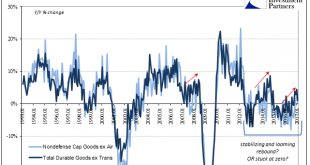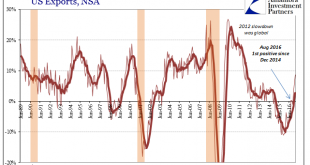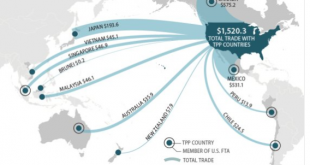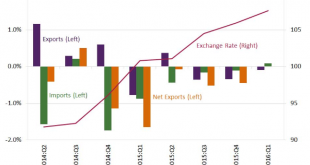New orders for durable goods (not including transportation orders) were up 1% year-over-year in February. That is less than the (revised) 4.4% growth in January, but as with all comparisons of February 2017 to February 2016 there will be some uncertainty surrounding the comparison to the leap year version. That would suggest that orders as well as shipments were somewhat better than they appear at least in in terms of...
Read More »US Trade Skews
US trade statistics dramatically improved in January 2017, though questions remain as to interpreting by how much. On the export side, US exports of goods rose 8.7% year-over-year (NSA). While that was the highest growth rate since 2012, there is part symmetry to account for some of it. Exports in the latter half of 2015 and for that first month of 2016 were contracting at double digit rates, the base effects of the...
Read More »The Misplaced Animosity toward Imports
Summary: Pity imports, they are misunderstood. Imports create jobs directly and indirectly. Restricting US imports would likely also curb exports. The mercantilist inclination by the Trump Administration makes it seem as if exports are good and create jobs and imports are bad and cost jobs. This is simply not true. This assessment is not based on newfangled thinking about trade. Rather Adam Smith argued...
Read More »Trade is Trump’s Centerpiece
Investors are anxiously awaiting more details on the new US Administration’s economic policies and priorities. Part of the challenge is that the cabinet represents a wide range of views and it is not clear where the informal power lies, or whose call is it. In terms of economic policy, trade is being given priority. It is seen as the key to the jobs and growth objectives. There have been two initiatives: formally...
Read More »NAFTA’s Effects on the US
On his blog, Dani Rodrik comments on NAFTA’s implications for US manufacturing and jobs. So here is the overall picture that these academic studies paint for the U.S.: NAFTA produced large changes in trade volumes, tiny efficiency gains overall, and some very significant impacts on adversely affected communities. … Mexico has been one of Latin America’s underperformers. So is Trump deluded on NAFTA’s overall impact on manufacturing jobs? Absolutely, yes. Was he able to capitalize on the...
Read More »Great Graphic: How a Strong Dollar Weighs on Net Exports
Investors appreciate that a strong dollar can impact US growth through the net export component of GDP. The dollar’s appreciation can push up the price of exports and lower the cost of imports. The St. Louis Fed took a look at how the strong dollar from 2014 to the beginning of 2016 impacted the net export function of GDP. It is clear that a strong dollar in this period was associated with a drag on growth from net...
Read More »Great Graphic: Trade and Tariffs-End of an Era?
This Great Graphic was tweeted by the Financial Time’s John Authers, who got it from @fathomcomment. The green line is the inversion of global trade (right-hand scale). The blue line is a trade-weighted average global tariff rate. What the chart shows is that since 1990, the decline in the average tariff coincided with an increase in trade (remember green line is inverted). However, the as chart illustrates, around the...
Read More »Trump Is Set To Label China A “Currency Manipulator”: What Happens Then?
While China has been banging the nationalist drums in its government-owned tabloids, warning daily of the adverse consequences to the US from either a trade war, or from Trump’s violating the “One China” policy, a more tangible concern for deteriorating relations between China and the US is that Trump could, and most likely will, brand China a currency manipulator shortly after taking over the the Oval Office. Even Bank...
Read More »Trade and Wage Inequality
In a CEPR discussion paper, Elhanan Helpman concludes that trade played an appreciable role in increasing wage inequality, but that its cumulative effect has been modest, and that globalization does not explain the preponderance of the rise in wage inequality within countries.
Read More »Richard Baldwin’s “The Great Convergence”
Link to slides of a presentation at the Peterson Institute. According to Baldwin, the new globalization (since 1990) reflects the fact that ICT enabled G7 firms to precisely control what goes on inside developing-nation factories.
Read More » Swiss Economicblogs.org
Swiss Economicblogs.org







